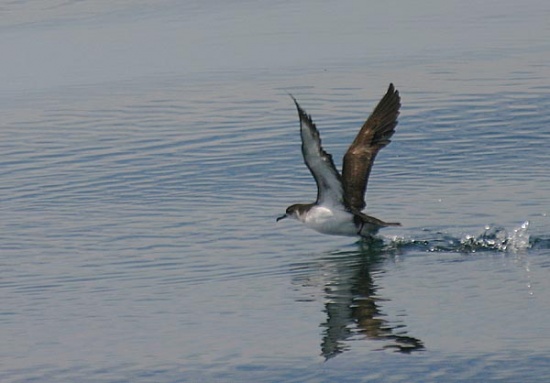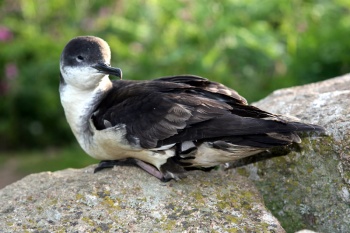Nutcracker (talk | contribs) (more details) |
Nutcracker (talk | contribs) m (format error) |
||
| Line 5: | Line 5: | ||
30-38 cm, wingspan 76-89 cm. Blackish or dark brown upper parts, white below, white wing linings, white crescent behind eye, short tail. | 30-38 cm, wingspan 76-89 cm. Blackish or dark brown upper parts, white below, white wing linings, white crescent behind eye, short tail. | ||
====Similar Species==== | ====Similar Species==== | ||
| − | [[Yelkouan Shearwater]], formerly considered a subspecies of Manx, is very similar, differing most obviously in its dark (not white) under-tail coverts, and longer legs which often project beyong the slightly shorter tail tip in flight; also usually marginally paler brown above.<br> | + | [[Yelkouan Shearwater]], formerly considered a subspecies of Manx, is very similar, differing most obviously in its dark (not white) under-tail coverts, and longer legs which often project beyong the slightly shorter tail tip in flight; also usually marginally paler brown above.<br /> |
| − | [[Balearic Shearwater]], also formerly considered a subspecies of Manx, is more distinctly paler brown above and dusky below, and with a somewhat 'pot-bellied' appearance in flight.<br> | + | [[Balearic Shearwater]], also formerly considered a subspecies of Manx, is more distinctly paler brown above and dusky below, and with a somewhat 'pot-bellied' appearance in flight.<br /> |
[[Audubon's Shearwater]] is smaller with shorter less-pointed wings, dark undertail coverts, and white spot near eyes.<br /> | [[Audubon's Shearwater]] is smaller with shorter less-pointed wings, dark undertail coverts, and white spot near eyes.<br /> | ||
[[Cory's Shearwater]] is much larger with much lighter brown body and wings, heavy yellow bill and white tail band.<br /> | [[Cory's Shearwater]] is much larger with much lighter brown body and wings, heavy yellow bill and white tail band.<br /> | ||
Revision as of 00:43, 14 December 2014
- Puffinus puffinus
Identification
30-38 cm, wingspan 76-89 cm. Blackish or dark brown upper parts, white below, white wing linings, white crescent behind eye, short tail.
Similar Species
Yelkouan Shearwater, formerly considered a subspecies of Manx, is very similar, differing most obviously in its dark (not white) under-tail coverts, and longer legs which often project beyong the slightly shorter tail tip in flight; also usually marginally paler brown above.
Balearic Shearwater, also formerly considered a subspecies of Manx, is more distinctly paler brown above and dusky below, and with a somewhat 'pot-bellied' appearance in flight.
Audubon's Shearwater is smaller with shorter less-pointed wings, dark undertail coverts, and white spot near eyes.
Cory's Shearwater is much larger with much lighter brown body and wings, heavy yellow bill and white tail band.
Great Shearwater is much larger with lighter body, smudgy brown belly, neat cap, narrow pointed wings. and white tail band.
Distribution
Manx Shearwater nests primarily in the eastern North Atlantic, most importantly on islands off the coasts of Britain (94% of the world population), with particularly important colonies on Rhum in western Scotland (approx 140,000 pairs), and Skokholm and Skomer in southwest Wales (about 150,000 pairs between the two islands). Smaller colonies also occur in Ireland, Iceland, the Faroe Islands, off Brittany in France, and on the Azores and Madeira. A recent colonist in the New World, with a small colony found off Newfoundland in Canada, and in 2009, the first confirmed young fledged within the USA, in Maine.
Outside breeding season, it migrates to southern Atlantic, south to at least 55°S off the coast of Argentina. Since the 1970s have been seen as a rare but increasingly regular vagrant in eastern north Pacific, and recorded as a vagrant in Australia and New Zealand.
Taxonomy
Up to seven other species has in the past been treated as subspecies of Manx Shearwater.
Habitat
Strictly pelagic when not breeding, and very mobile, with e.g. birds from Skokholm making 1,500 km round trips to the Bay of Biscay to get food for their chicks.
Behaviour
Flight
Glides and banks low over the water on stiff straight wings, with bursts of wingbeats followed by long glides; in stronger winds, often arcs high over waves to increase flying efficiency by picking up gusts deflected by the waves. One of the longest-lived birds in the world, with individuals over 50 years old known, and calculated to have flown eight million km in their lifetimes2.
Breeding
Nests colonially in burrows on grassy slopes of islands, often at some distance from the sea. Visits burrows after dark.
Vocalisation
<flashmp3>Puffinus puffinus (song).mp3</flashmp3>
Listen in an external program
References
- Clements, J. F., T. S. Schulenberg, M. J. Iliff, D. Roberson, T. A. Fredericks, B. L. Sullivan, and C. L. Wood. 2014. The eBird/Clements checklist of birds of the world: Version 6.9., with updates to August 2014. Downloaded from http://www.birds.cornell.edu/clementschecklist/download/
- New Scientist (25 April 2003) Venerable bird notches five million air miles
- Collins Field Guide 5th Edition
External Links





